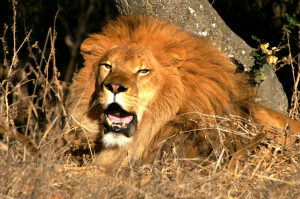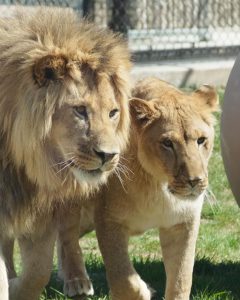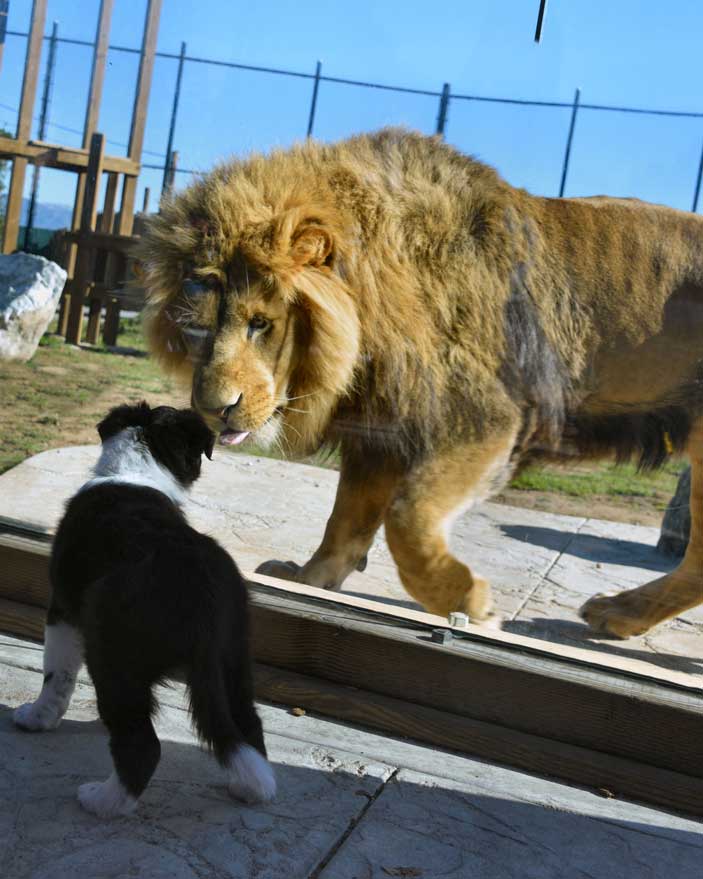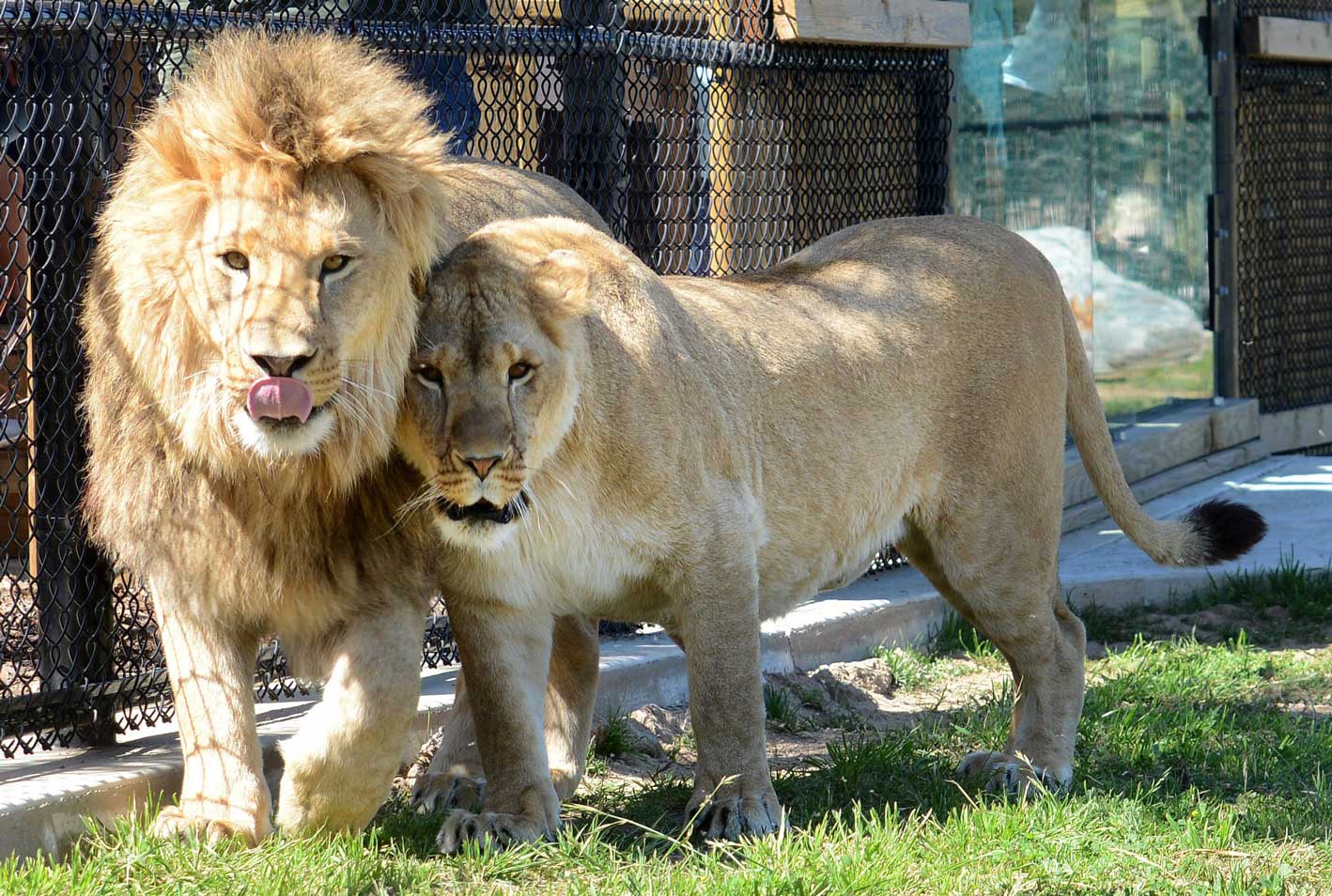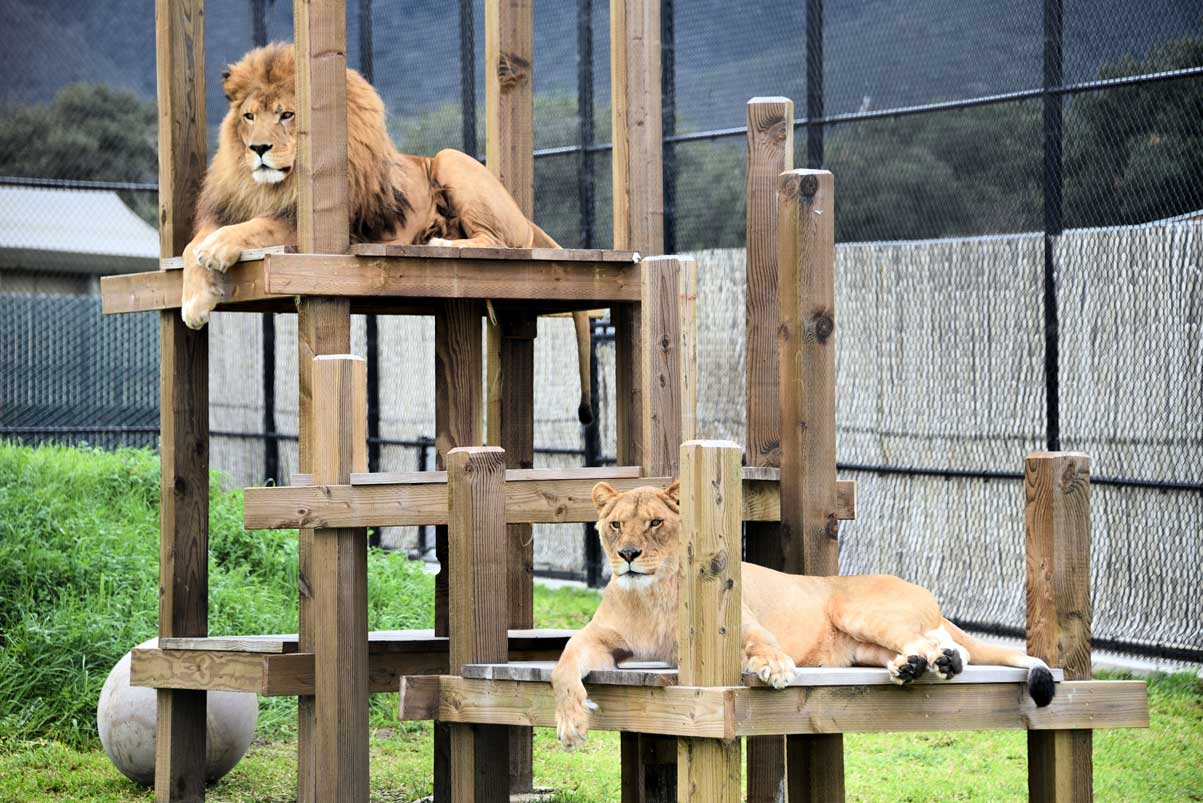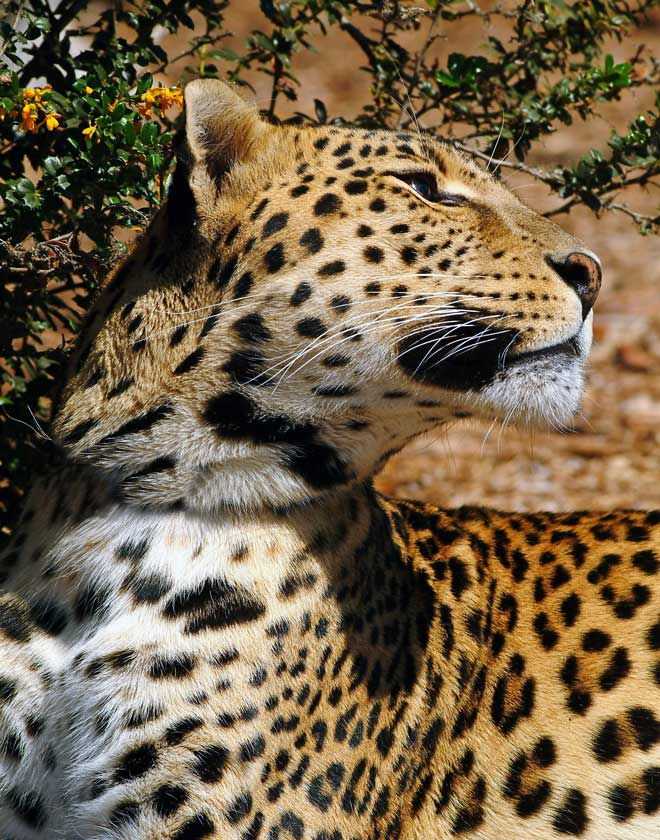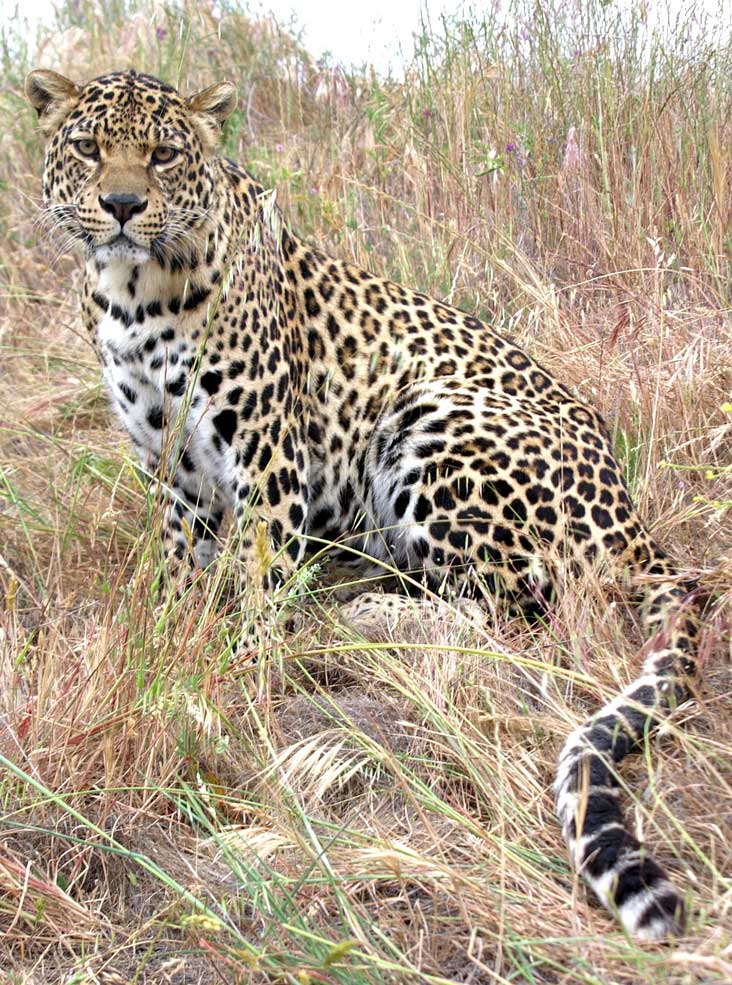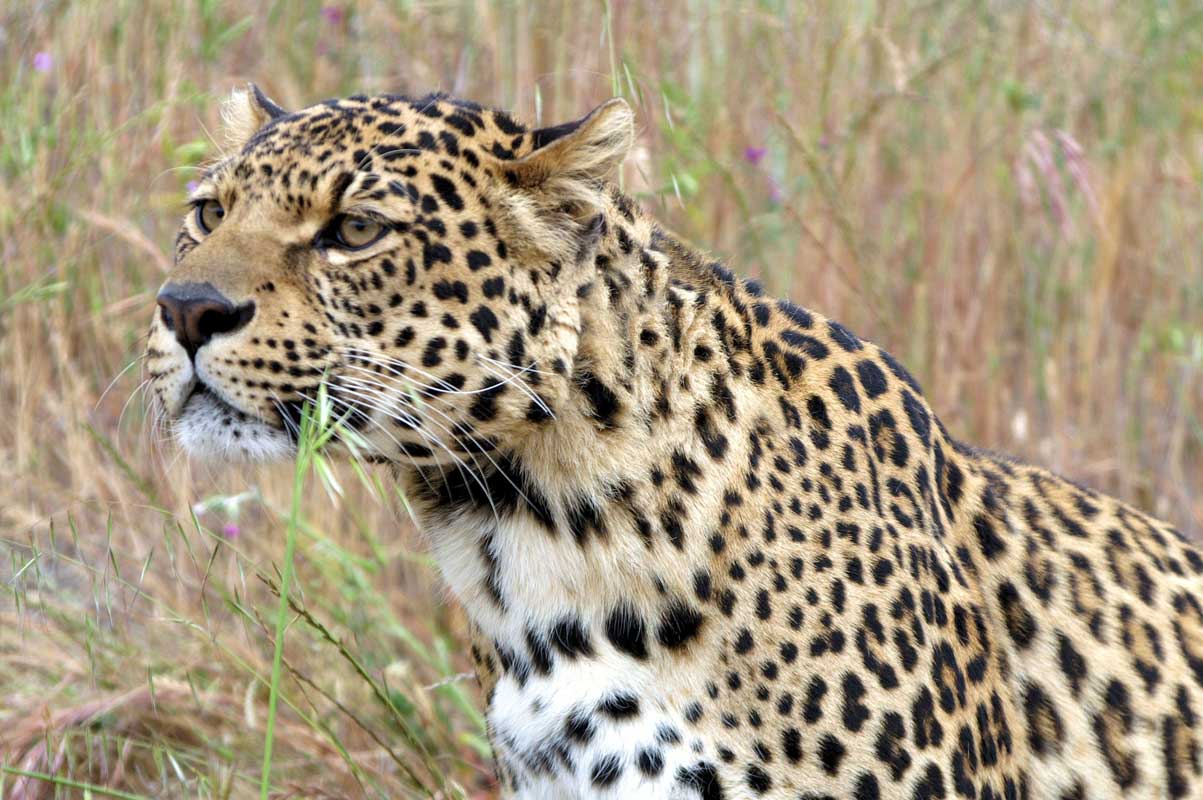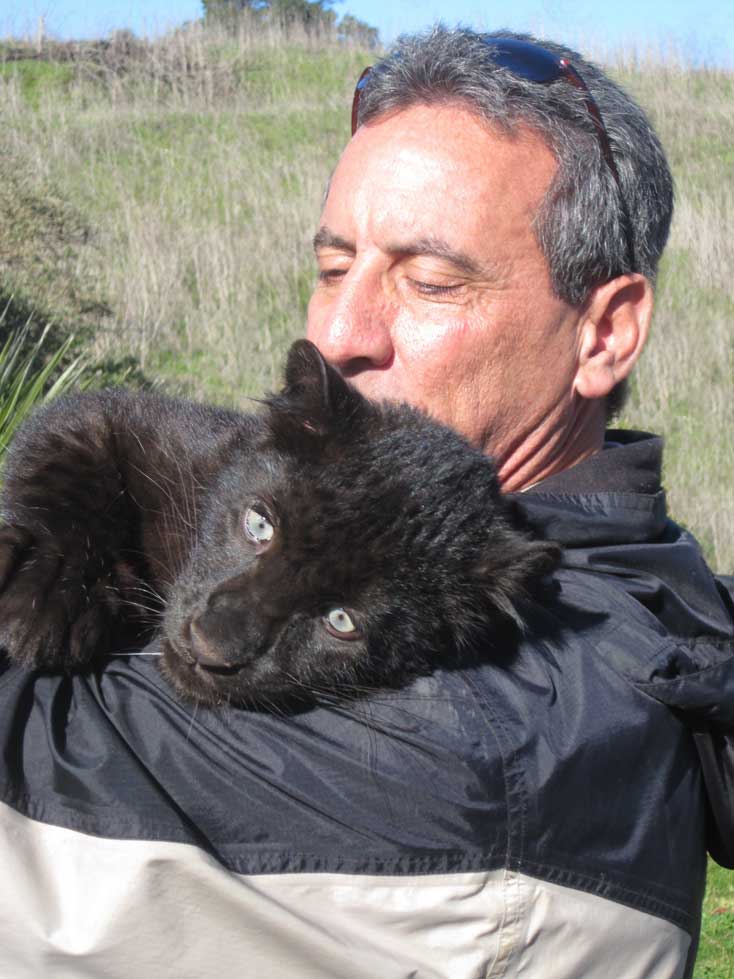
Introducing “OZ”, and exhibit at Monterey Zoo that our lions, tigers and bears call home. A “magical place” we invite all to come visit and see for themselves how special these animals truly are.
Our Lions
The Monterey Zoo is home to four majestic African Lions. Jacob came from a big-cat sanctuary in Colorado. Zoo director, Charlie Sammut, learned that he was related to “Josef”, a founding animal of Monterey Zoo and VERY special part of Charlie’s life and career. In fact, the silhouetted lion in the logo is in honor of Josef. At the Monterey Zoo, Jacob was recently paired up with a lone lioness in keeping with zoo’s attempt to pair as many animals as possible to increase mental stimulation and quality of life.
Zeus and Athena came to Monterey Zoo in 2016. The previous owner of the brother and sister team was looking for a suitable home for the dynamic pair. One look at the new exhibit space at the Monterey Zoo and the search was over. Today, they are INSEPARABLE and spend hours chasing each other, playing and entertaining all who visit.
African Lion (Panthera Leo)
“The King of the Jungle”
Lions are the only cats that live in groups, which are called prides. Prides are family units that may include up to three males, a dozen or so females, and their young. All of a pride’s lionesses are related, and female cubs typically stay with the group as they age. Young males eventually leave and establish their own prides by taking over a group headed by another male. Males defend the pride’s territory, which may include some 100 square miles.
Diet
Lions consume a wide variety of prey, from wildebeest, impala, zebra, giraffe, buffalo and wild hogs to sometimes rhinos and hippos. They will also feed on smaller animals such as hares, birds and reptiles. Lions are also known to attack elephants when food is scarce.
Facts
Height: 3.9 ft. (male adult at shoulder), 3.6 ft. (female adult at shoulder)
Mass: 420 pounds (adult male), 280 pounds (adult female)
Lifespan: 10 – 14 years (Adult, In the wild)
Conservation Status
The lion population in Africa has been reduced by half since the early 1950s. Today, fewer than 21,000 remain in all of Africa.
Did you know?
Female lions are the pride’s primary hunters. They often work together to prey upon antelopes, zebras, wildebeest, and other large animals of the open grasslands. Many of these animals are faster than lions, so teamwork pays off.
Our Tigers
Come and meet the beautiful Bengal tigers living and thriving at the Monterey Zoo. All of our tigers came to us from a breeding facility in South Carolina. Our males and females are paired by sex and kept separate to prevent unwanted breedings, as well as to protect them as they were not raised together and our boys are much larger than our girls. The new tiger exhibit was the first step to becoming a real zoo. Since then the zoo has grown and added several other exciting state-of-the-art exhibits, but it started with the tigers.
Bengal Tiger (Panthera tigris)
Largest Cat Species
Tigers live alone and aggressively scent-mark large territories to keep their rivals away. They are powerful nocturnal hunters that travel many miles to find buffalo, deer, wild pigs, and other large mammals. Tigers use their distinctive coats as camouflage (no two have exactly the same stripes). They lie in wait and creep close enough to attack their victims with a quick spring and a fatal pounce.
Diet
Tigers are carnivores. They prefer hunting mammals such as chital, sambar, gaur and sometimes water buffalo, wild boar and hog deer. Because of the encroachment of humans into their habitat, they also prey on domestic livestock.
Facts
Height: 3 to 3.5 feet (at shoulder)
Mass: 500 pounds (male), 310 (female)
Lifespan: 10 to 15 years (in the wild)
Conservation Status
Today, due to habitat loss caused by deforestation, and hunting by human poachers, the Bengal tiger is considered to be an endangered species. Despite being the most common of all the tiger species, there are thought to be only around 2,000 Bengal tigers left in the wild.
Did you know?
Tigers are the largest members of the cat family and are renowned for their power and strength.
African Spotted Leopard (Panthera pardus)
Strong and Fast
Picasso came to Monterey Zoo from a breeder in the Eastern United States and was unfortunately diagnosed with a heart murmur as a baby. His wasn’t expected to live beyond five years but with a carefully monitored diet, and exceptional care, he’s been with us twice as long and we expect he’ll be with us much longer. Our second Spotted Leopard, Oz, is one of the most beautiful spotted leopards you will ever see. His beauty will be even more spectacular when sharing space with Picasso in a beautiful new exhibit one day.
The leopard is solitary and territorial, as are several other felids; individuals associate appreciably only in the mating season, though mothers may continue to interact with their offspring even after weaning. Mothers have been observed sharing kills with their offspring when they can not obtain any meal. The leopard depends mainly on its acute sense of hearing and vision for hunting. Hunting is primarily a nocturnal activity in most areas.
Diet
The leopard is a carnivore that prefers medium size prey. Leopards must compete for food and shelter with other large predators. These animals may steal the leopard’s kill, devour its young or even kill adult leopards.
Facts
Height: 24 to 28 inches (male at shoulder), 22-25 inches (female at shoulder)
Mass: 82 to 200 pounds (male), 62-132 pounds (female)
Lifespan: 12 to 17 years (in the wild)
Conservation Status
Listed as vulnerable because leopard populations are declining in large parts of their range.
Did you know?
Leopards are astoundingly strong. They are pound for pound the strongest of the big cats. They are able to climb trees even when carrying heavy prey. Leopards sometimes take their prey up trees so that lions and hyenas can’t steal them.
Melanistic African Spotted Leopard (Panthera pardus)
“Black Panther”
A “black panther” is not its own species—it’s an umbrella term that refers to any big cat with a black coat. The condition is caused by genetics, which regulates the distribution of black pigment within the hair shaft. It’s most well known in leopards, which live in Asia and Africa. Meet Cosmo at the Monterey Zoo.
Diet
The leopard is a carnivore a that prefers medium-sized prey, mainly antelopes, deer and rodents.
Facts
Height: 24-28 inches (male at shoulder), 22-25 inches (female at shoulder)
Mass: 82-200 pounds (male). 62-132 pounds (female)
Lifespan: 12-17 years
Conservation Status
It is listed as vulnerable by the IUCN because leopard populations are declining in large parts of their range. They are threatened by habitat loss and pest control.
Did you know?
The leopard depends mainly on its acute sense of hearing and vision for hunting, which is done primarily at night.


